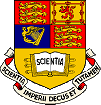|
Rosetta will be launched on the 12 January 2003 by Ariane-5
from Kourou, French Guiana on a mission of more than ten years.
The Rosetta mission is an interplanetary mission with the
objective to rendezvous with, and make in-situ measurements
of comet 46 P/Wirtanen.
 |
Comet 46P/Wirtanen imaged
with the MPG/ESO 2.2 m Telescope in September 1996.
Comet 46 P/Wirtanen was discovered on 15 January 1948
at Lick Observatory by Carl A. Wirtanen. The dust coma
and the already developed dust tail are visible.
|
The Rosetta Orbiter will be the first spacecraft ever
to go into orbit around a comet nucleus. It will also be the
first to observe the changes that occur in comet activity
as the nucleus travels towards the inner Solar System. The
spacecraft will also carry the Rosetta Lander (Surface
Science Package) to the nucleus and deploy it onto the comet's
surface.
The Rosetta spacecraft will undergo an eight year journey,
after which it will perform its rendezvous manoeuvre with
the comet on the 29 November 2011 and make in-situ measurements
in August 2012. Studies will be made of the nucleus of comet
Wirtanen and its environment in great detail for a period
of nearly two years, the near-nucleus phase starting at a
heliocentric distance of about 3.25 AU, with far-observation
activities leading ultimately to close observation (from about
one km distance).
To be able to fly alongside its target comet, the Rosetta
spacecraft must put itself into the same orbit as the comet
around the Sun.
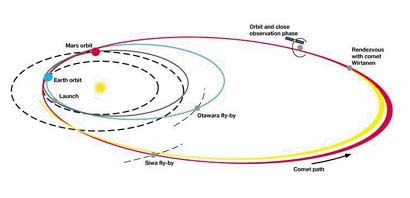 |
| The above figure shows the
several fly-bys required for Rosetta to achieve its rendezvous
with Comet Wirtanen. Rosetta's orbit grows in stages until
it matches the comet's. |
At the Earth's distance from the Sun, Comet Wirtanen travels
faster than that of Earth. No rocket now available could give
Rosetta the extra speed it needs to catch the comet. Instead,
the spacecraft will swing past Mars and twice past the Earth,
exploiting the planets' gravity to gain the necessary energy.
The spacecraft will also pass close to two asteroids, Otawara
and Siwa on its route. Scientists want to know whether some
of the asteroids orbiting near the Earth are in fact dead
comets. The dark coloured Siwa may be more similar to what
a defunct comet would look like.
The Rosetta design is based on a box-type central structure,
2.8 m x 2.1 m x 2.0 m, on which all subsystems and payload
equipment are mounted. Two solar panel wings, each of 32 m2,
extend outwards from the side faces, giving a total span of
about 32 m tip to tip. Rosetta is the first spacecraft to
travel further than Mars and rely on the diminishing power
of the Sun's rays, for warmth and electric energy. For this
reason ESA is developing special low-intensity, low-temperature
solar cells.
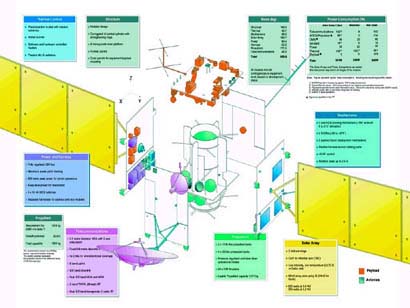 |
| |
| The figure above shows the
Rosetta spacecraft design. |
Attached to the face opposite the high-gain antenna, until
its release, is the Lander. The payload instruments are accommodated
on the top of the spacecraft, and the subsystems on the base
of the spacecraft. The instrument panel on the top of the
spacecraft almost always points towards the comet during the
main scientific phase of the mission, while the antennas and
solar arrays point towards the Sun and Earth (at such great
distances the Earth is relatively speaking in the same direction).
The spacecraft attitude concept is such that the side and
back panels are shaded throughout all nominal mission phases,
offering a good location for radiators and louvres. This will
normally be facing away from the comet, minimising the effects
of cometary dust.
The Rosetta mission will offer a major step forward in cometary
science. It will provide detailed observations of the comet
nucleus and its close environment and will provide unique
sample analysis capabilities, thus satisfying to a large extent
the objectives of the original comet-nucleus sample-return
mission.
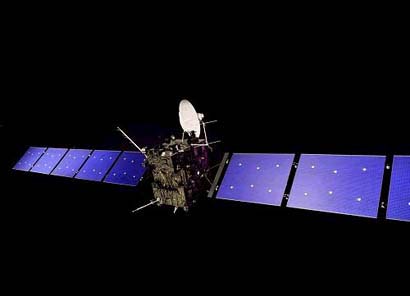 |
| |
| The figure above shows the
Rosetta spacecraft with its side mounted solar panel wings
extended and the high gain antenna on its rear side. |
This mission follows from the 'reconnaissance phase' of cometary
comae and nuclei by the fast fly-by's of ICE at comet Giacobini-Zinner,
Vega 1 and 2, Susei, Sagigake and Giotto at comet Halley and
the Giotto Extended Mission to comet Grigg-Skjellerup,
The Rosetta Homepage
at the European Space Agency.
| Instruments Onboard Rosetta |
Rosetta's onboard instruments will concentrate on the in-situ
investigation of cometary matter and the structure of the
nucleus, with the added potential of studying the evolution
of cometary processes as a function of heliocentric distance.
The spacecraft will study the appearance of the comet's surface,
its composition and temperature distribution and analyse the
gas and dust emitting from its nucleus. It will determine
dust and gas emission rates and investigate the interaction
with the solar wind.
The obiter payload comprises eleven separate scientific investigations,
plus the lander. For a list of these scientific investigations,
and links to the specific investigations please visit the
Related Links page.
The function of the Lander will be to make in-situ studies
of the composition and structure of the nucleus material.
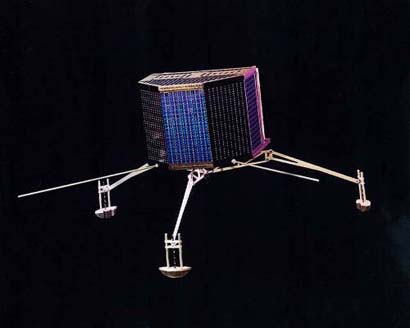 |
| |
| Image of the Rosetta Lander.
The Lander science will focus on the in situ study of
the composition and structure of the nucleus material. |
After the asteroid flyby in 2008, the spacecraft enters a
heliocentric drift phase to intercept the comet at a point
close enough to allow communication with Earth. The spacecraft
will lower its velocity relative to that of Comet P/Wirtanen
from 100 meters/second at 500,000 kilometre distance to a
speed low enough to allow it to go into an elliptic polar
orbit about the nucleus, using the images of the comet as
it gets closer to fine-tune the approach. This will occur
in August 2011, about 3150 days after launch. A landing site
will then be chosen and the probe will be released in August
2012 to land on the comet's surface and perform in-situ measurements.
The Rosetta Lander
Web Server at the Max-Planck-Institut für Aeronomie.
This page was last updated September 2002.
|
